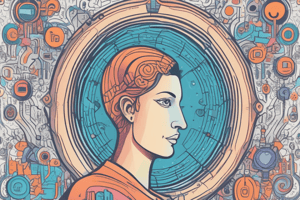Podcast
Questions and Answers
What is equity, according to the provided text?
What is equity, according to the provided text?
Equity is about fairness, ensuring everyone has what they need to succeed.
What is the purpose of Non-Governmental Organizations (NGOs)?
What is the purpose of Non-Governmental Organizations (NGOs)?
NGOs work independently from government bodies to promote change and address social issues.
Explain what 'Optical Advocacy' refers to.
Explain what 'Optical Advocacy' refers to.
Optical Advocacy refers to actions that seem helpful but primarily focus on creating a positive public image rather than bringing about real change.
Which of the following aspects are included in the definition of 'Privilege'?
Which of the following aspects are included in the definition of 'Privilege'?
Signup and view all the answers
What is 'Reconciliation' according to the text, and in what context is it particularly important?
What is 'Reconciliation' according to the text, and in what context is it particularly important?
Signup and view all the answers
Social media can be used to spread misinformation.
Social media can be used to spread misinformation.
Signup and view all the answers
Which of these options is NOT a type of advocacy mentioned in the text?
Which of these options is NOT a type of advocacy mentioned in the text?
Signup and view all the answers
What is the main advantage of using social media for activism?
What is the main advantage of using social media for activism?
Signup and view all the answers
Which type of advocacy can be effective for formal petitions and reaching decision-makers?
Which type of advocacy can be effective for formal petitions and reaching decision-makers?
Signup and view all the answers
Which type of advocacy is best for raising awareness quickly and rallying people online?
Which type of advocacy is best for raising awareness quickly and rallying people online?
Signup and view all the answers
What is the main limitation of social media campaigns, according to the text?
What is the main limitation of social media campaigns, according to the text?
Signup and view all the answers
Sit-ins are a peaceful form of protest that physically disrupts systems.
Sit-ins are a peaceful form of protest that physically disrupts systems.
Signup and view all the answers
What is the role of Teach-ins in advocacy?
What is the role of Teach-ins in advocacy?
Signup and view all the answers
What is the author's opinion on the most effective form of advocacy?
What is the author's opinion on the most effective form of advocacy?
Signup and view all the answers
How do power imbalances in the school system manifest according to the text?
How do power imbalances in the school system manifest according to the text?
Signup and view all the answers
Social media makes it easier for students to expose issues and organize for change in schools.
Social media makes it easier for students to expose issues and organize for change in schools.
Signup and view all the answers
What does the author argue is the real power of collective resistance?
What does the author argue is the real power of collective resistance?
Signup and view all the answers
Study Notes
Equity and Inequality
- Equity focuses on fairness, ensuring everyone's needs are met.
- Institutional power is control held by organizations, often leading to inequality.
- Media bias occurs when news outlets or social media present information to favor a specific viewpoint, distorting reality.
- NGOs (Non-governmental Organizations) independently address social issues.
- Optical advocacy aims to improve public image rather than create real change.
- Privilege refers to advantages based on race, wealth, or social status.
- Reconciliation addresses historical wrongs, particularly for Indigenous communities.
Social Media Advocacy
- Social media is a powerful tool for activism and media advocacy.
- It enables rapid information sharing, protest organization, and awareness raising for social issues (e.g., racial inequality, climate change, gender justice).
- It can connect people globally, bringing attention to local issues like those in Peel Region, Ontario.
- Social media can be a platform for harassment and manipulation.
- Misinformation spreads quickly online.
Activism Evolution
- Social media has made activism more accessible and widespread.
- Online campaigns (like #BlackLivesMatter and #MeToo) have reached millions.
- Actions previously requiring physical spaces (protests, letter-writing) can now be done online.
Types of Advocacy
- Letter-hand campaigns: Effective for formal petitions and reaching decision-makers.
- Protests: Create a visible presence but may not always result in immediate change.
- Social media campaigns: Effective for quickly spreading messages, raising awareness but lacking follow-through.
- Galas: Raise funds and awareness, but can be disconnected from grassroots efforts.
- Sit-ins: Powerful form of direct protest, physically disrupting systems, but can lead to tension.
- Teach-ins: Educate people on issues, effective if reaching the right audience.
Power Imbalances in Schools
- Power imbalances in schools manifest in resource distribution, treatment of certain groups (e.g., racial minorities, students with disabilities), and how voices in power influence decision-making.
- Social media has facilitated student organization and highlighting these issues (e.g., discriminatory practices or unequal access).
- Effective advocacy combines digital and physical actions. Social media spreads awareness, while tangible actions (e.g., protests, sit-ins) demonstrate collective power.
Studying That Suits You
Use AI to generate personalized quizzes and flashcards to suit your learning preferences.
Related Documents
Description
Explore the concepts of equity and inequality, focusing on how institutional power, privilege, and media bias contribute to social disparities. Discover the role of NGOs and social media as tools for advocacy and activism in addressing these issues. This quiz will test your understanding of these critical societal topics.




